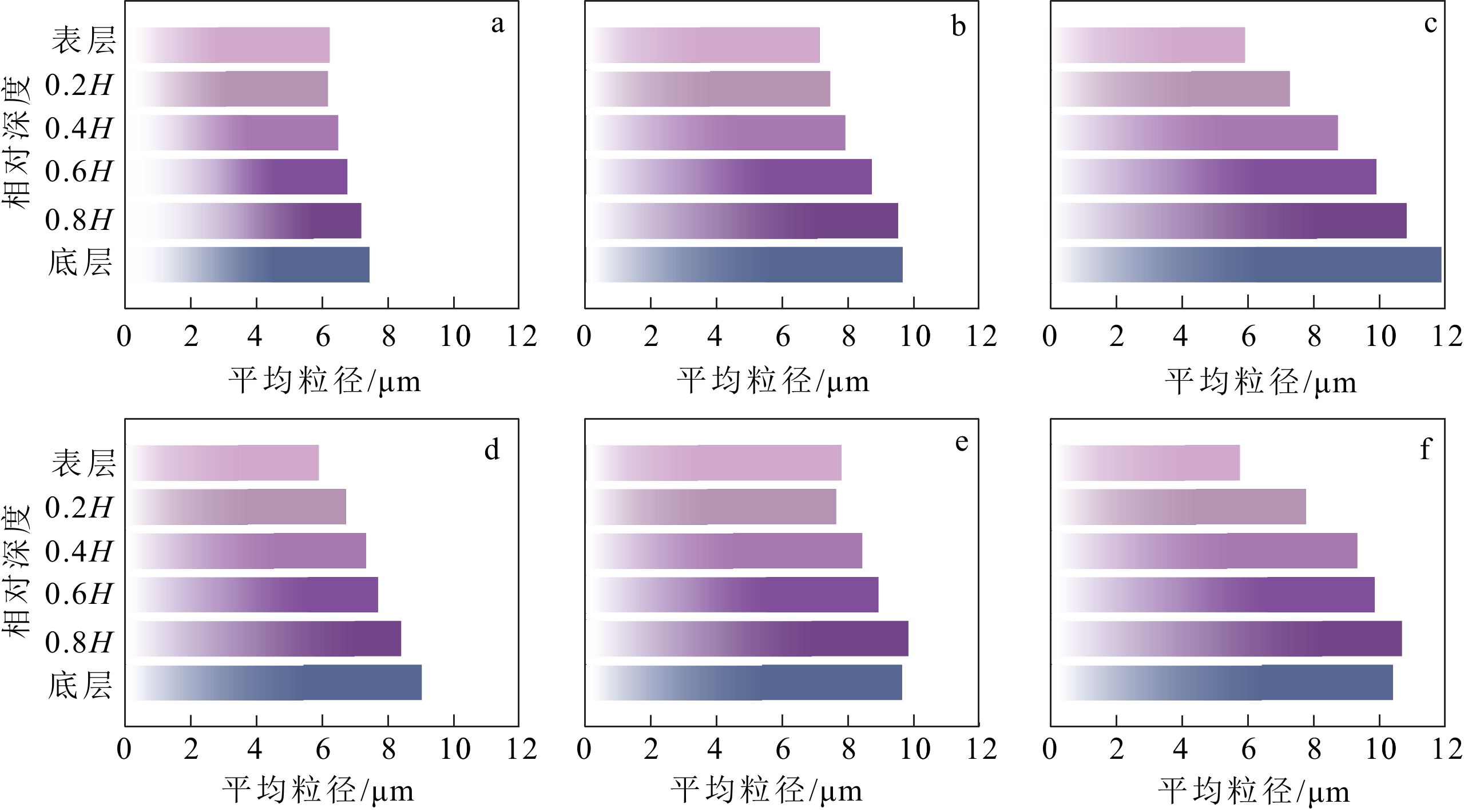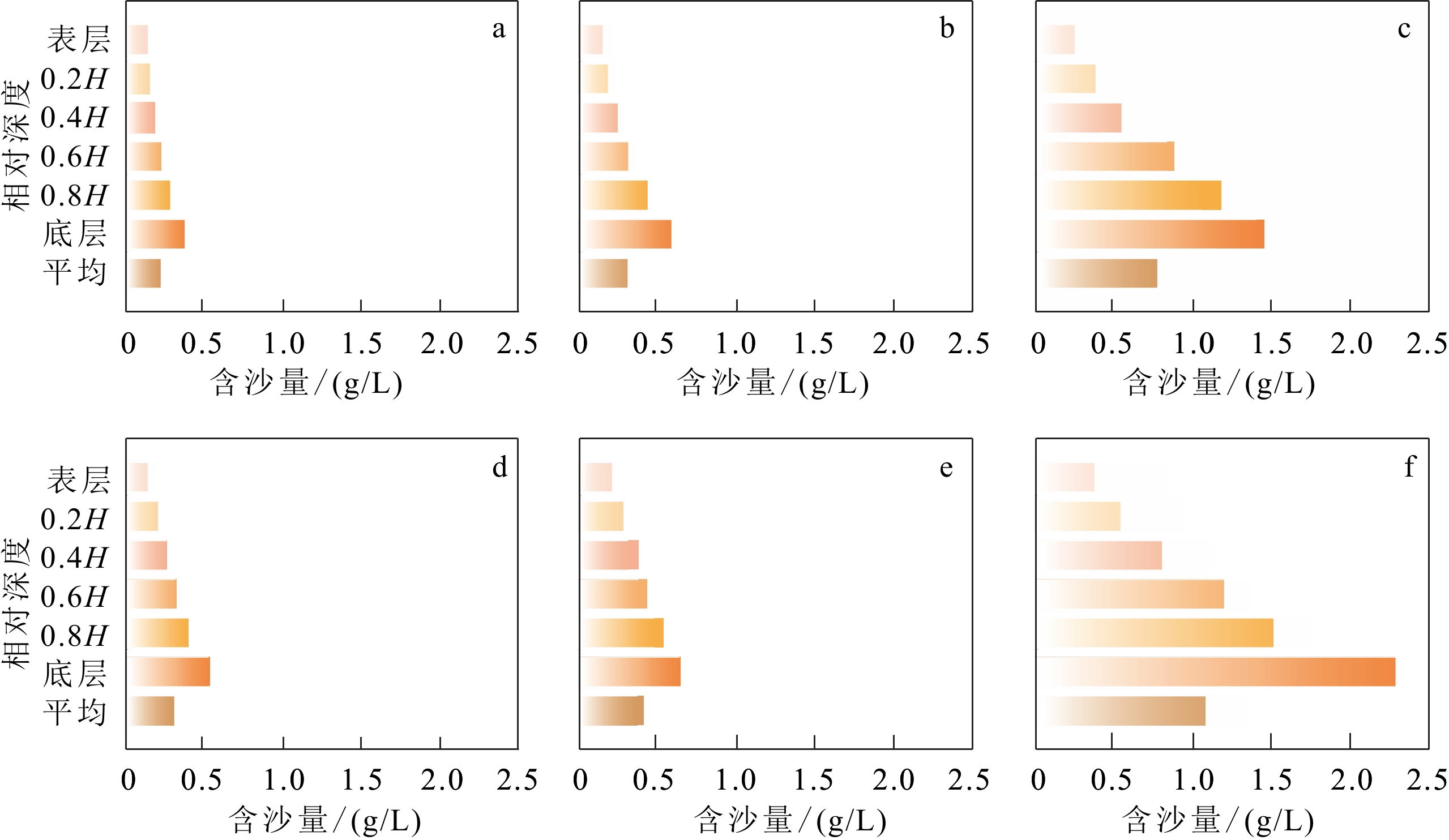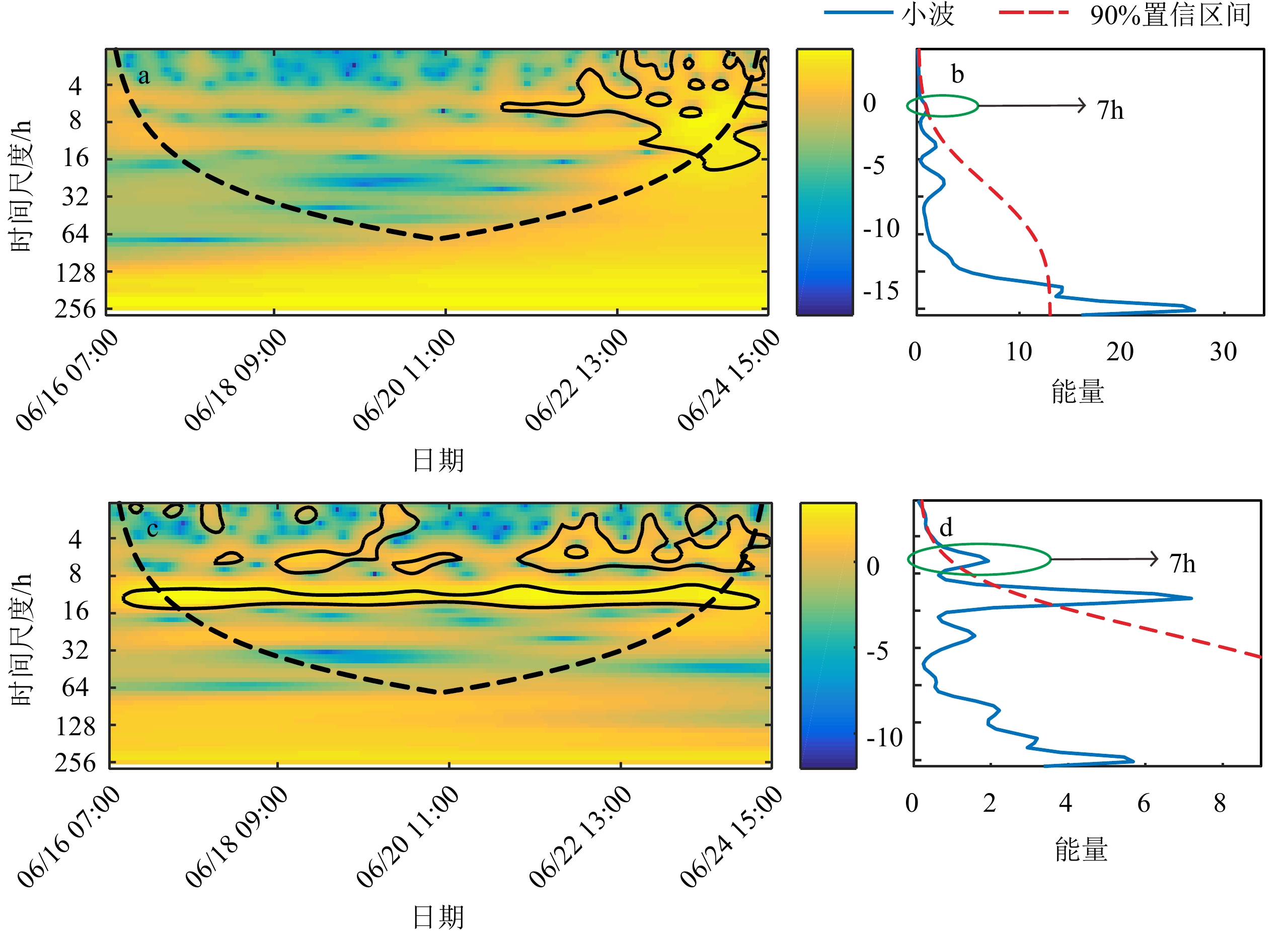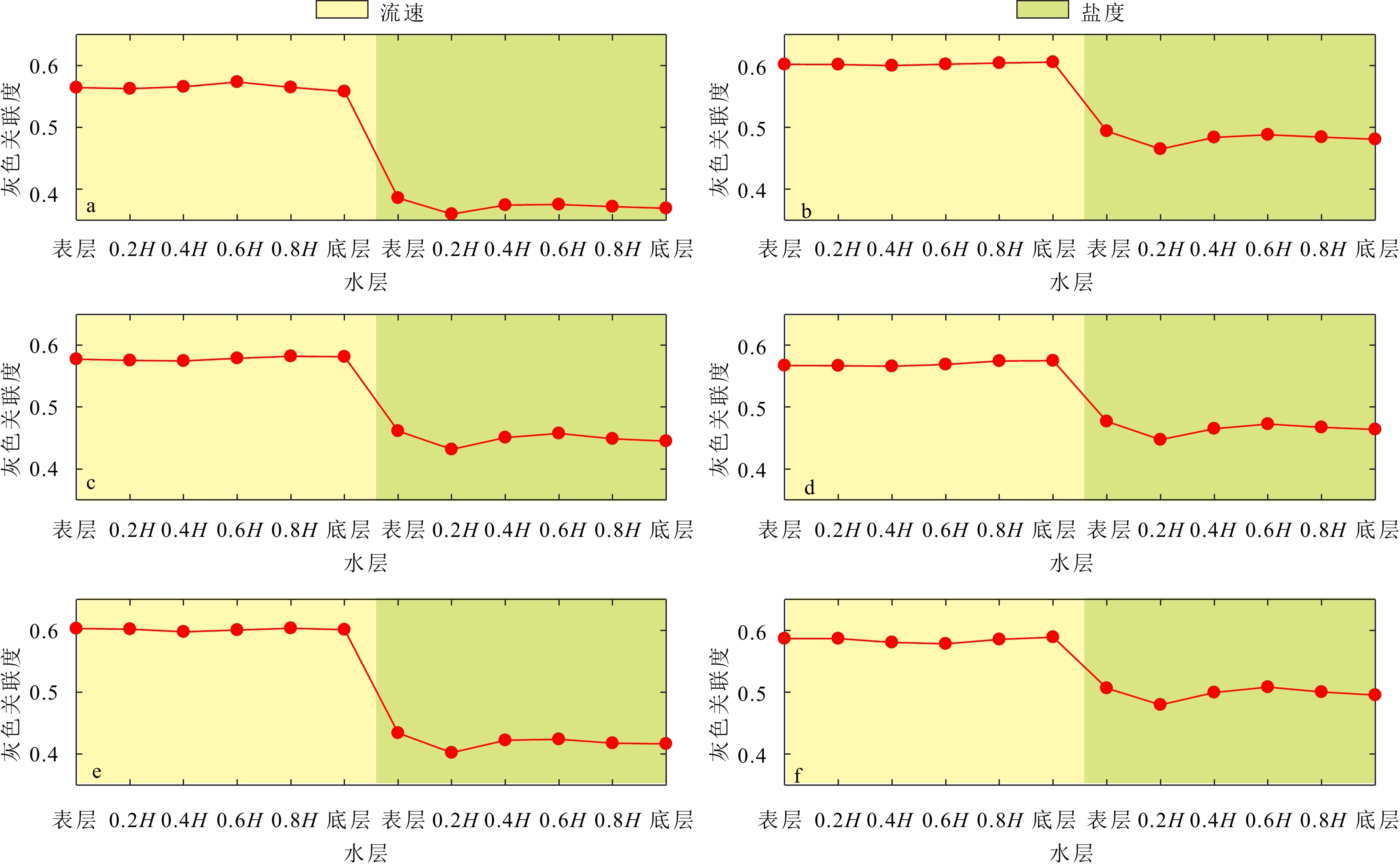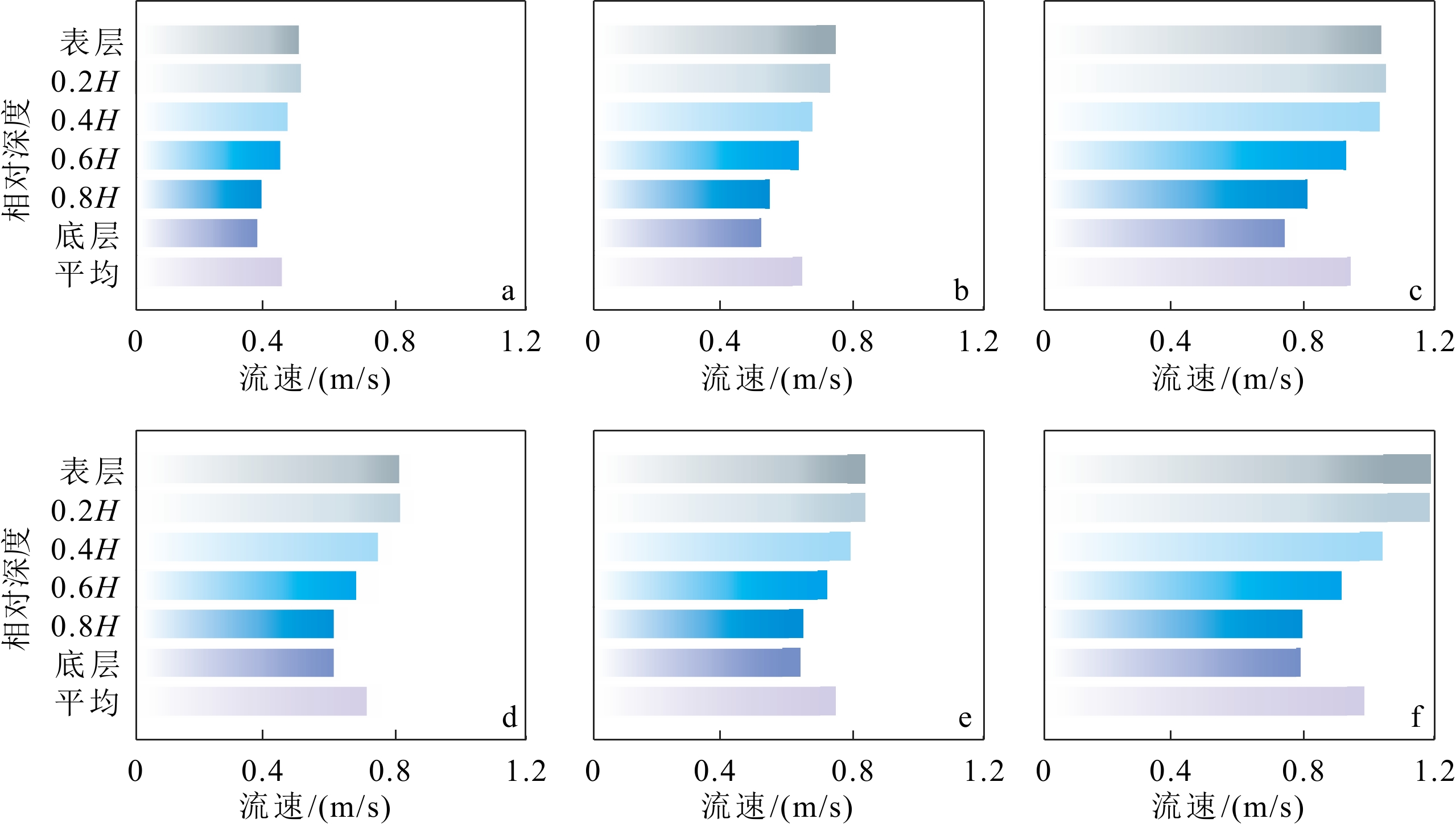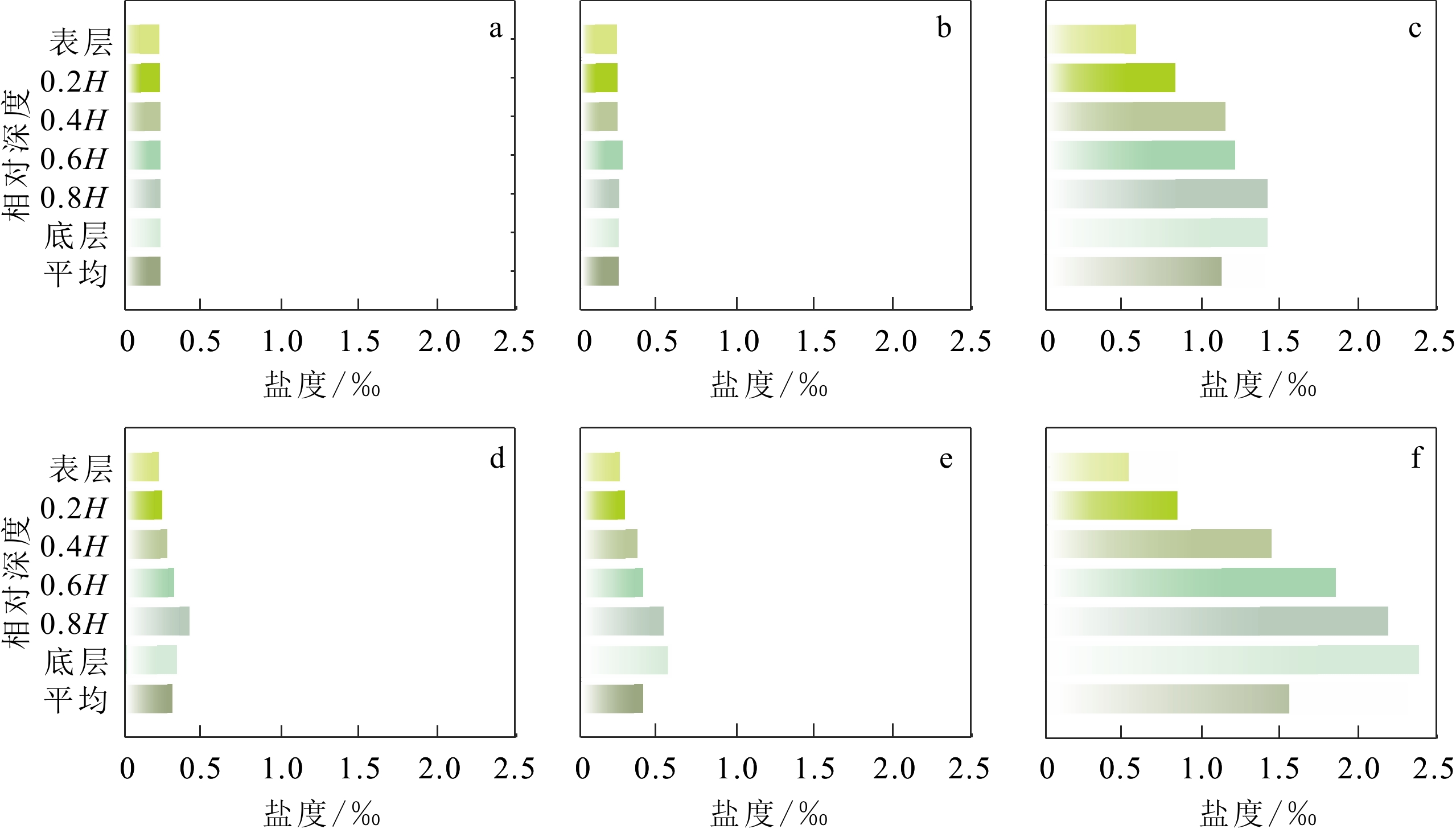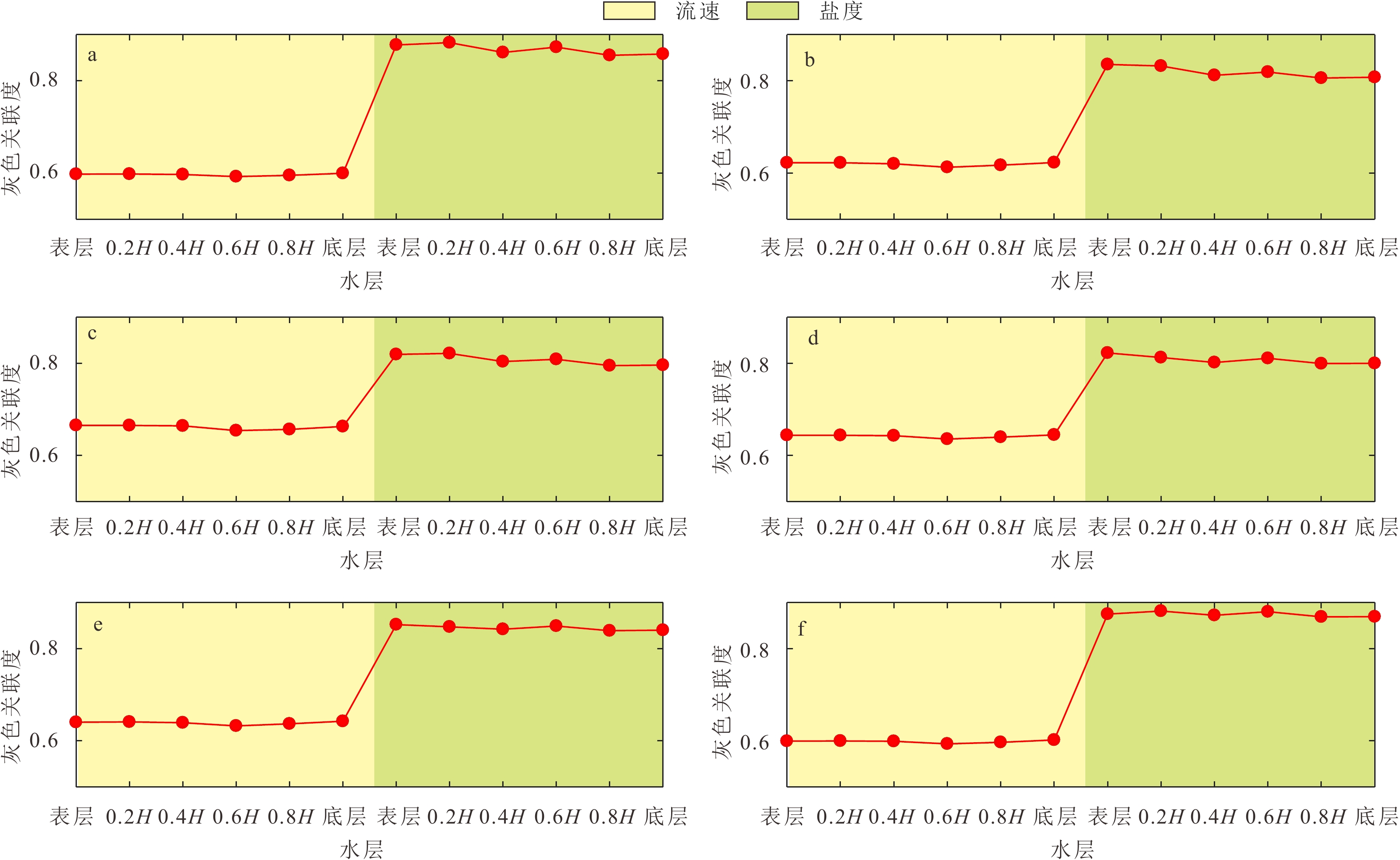The vertical changes of suspended sediment in the turbidity maximum zone along the South Passage of the Changjiang River Estuary
-
摘要: 最大浑浊带水体悬沙时空变化过程是河口沉积动力学研究的核心内容之一。利用2013年6月16—24日在长江口南槽最大浑浊带自小潮至大潮连续9天的逐时定点水文及悬沙观测资料,分析南槽最大浑浊带悬沙垂向变化特征及影响机制,由此加深对长江口最大浑浊带形成及变化的理解。主要结果包括:(1) 南槽最大浑浊带悬沙平均粒径为3.52~18.84 μm。从小潮到大潮、从表层水体到底层水体,悬沙粒径逐渐增大,水体含沙量逐渐增大,含沙量为0.12~2.29 g/L。(2)水体流速呈现自下而上、自小潮到大潮逐渐增大的态势,与悬沙粒径的关联度较好;而水体盐度呈现自上而下、自小潮到大潮逐渐增大的态势,与悬沙含量的关联度较好。(3)南槽最大浑浊带水体悬沙垂向变化涵括两种控制机制:涨落潮作用引起的底沙再悬浮控制水体悬沙约7 h的周期性变化;涨潮流挟带的口外泥沙絮凝形成的絮团在涨潮流和重力作用的影响下引起水体悬沙出现约14 h的周期性变化特征。Abstract: Temporal and spatial variation processes of suspended sediment in the estuary turbidity maximum zone (TMZ) is one of the crucial issues of estuarine sedimentation dynamics. Based on hourly hydrological data and suspended sediment samples collected on June 16—24, 2013 covering a complete neap-spring tide cycle, the vertical changing characteristics and related dominant mechanism of suspended sediments in the TMZ in the South Passage (SP) were analyzed to deepen the understanding of TMZ formation and evolution in the Changjiang River estuary. Results show that: (1) the average grain size of the suspended sediment ranged 3.52~18.84 μm while the suspended sediment concentration (SSC) fluctuated between 0.12 ~2.29 g/L. The SSC was increased from neap tide to spring tide in temporal scale, and from surface to bottom in spatial scale. (2) The current velocity increased from bottom to surface and from neap tide to spring tide, and correlated closely with the average grain size of suspended sediment. The salinity decreased from bottom to surface and from spring tide to neap tide and correlated closely with the SSC. (3) The vertical changes of the suspended sediment exhibited two types of controlling mechanisms: the bed sediment resuspension under flood and ebb tidal forces, which generated a periodical change of 7 hours, and the sediment flocculation under the forces of flood tide and gravity, which generated a periodical change of 14 hours.
-
河口区发育的最大浑浊带有其独特的沉积动力过程[1]。该区域水体悬沙受盐度与水动力等条件的制约,时空不对称性显著[2]。径流来沙、口外来沙及底泥再悬浮在物质供给上控制了河口最大浑浊带的悬沙变化特性。河口最大浑浊带悬沙的变化又通过影响河口拦门沙的冲淤引起拦门沙航槽的船舶通行能力。因此研究河口最大浑浊带悬沙的时空变化具有较重要的理论与实践研究价值[3]。
国外不少研究者先后针对悬沙交换[4]、悬沙浓度变化[5]、悬沙垂向变化[6]、河口最大浑浊带位置[7]以及悬沙输移[8]进行分析,提出河口最大浑浊带是由水动力和沉积物动态变化过程产生的,而人类干扰常导致高混浊河口的产生。流域向河口排放的水流量没有明显的变化趋势,而泥沙量呈阶梯状急剧下降,导致进入长江河口的泥沙量明显减少,悬沙浓度减小。填海工程的影响使得悬沙浓度显著下降,并导致河口最大浑浊带向海移动[9]。此外,泥沙输运和再悬浮导致的悬沙空间变化也是最大浑浊带河道地貌变化的关键驱动因素[10]。同时,国内学者对珠江口[11]、黄河口[12]以及长江口[13]进行了分析,其中河口重力环流对珠江中河口最大浑浊带的发展起重要作用[14];影响黄河口最大浑浊带的主要因子是重力环流的强度、泥沙粒径以及入海水体和海域涨潮水体的含沙浓度[15];长江口最大浑浊带悬沙浓度在时间上呈现大潮显著高于小潮,涨落潮平均浓度接近的特点[16],近年来其位置受人类活动和径潮流作用的控制[17],其宽度变化与入海沙量多寡关系密切[13]。长江口北港、北槽和南槽悬沙在径流、潮流、盐淡水异重流共同作用下,形成上层水流净向海,下层水流在滞流点下游净向陆的河口环流[18]。然而,前述研究主要聚焦于悬沙特性较大尺度的分析,全潮周期内的悬沙垂向分布研究较少。针对长江口南槽最大浑浊带悬沙垂向动态变化的工作并不多见。
作为长江“三级分汊,四口入海”的重要分流河口,南槽是东海和长江水沙交换的重要通道,也是长江口航运的节点枢纽。南槽最大浑浊带悬沙时空分布在较大程度上影响南槽动力地貌的变化过程,进而控制南槽水运资源的发展。基于此,本文通过逐时采集的南槽最大浑浊带连续9天的水沙资料,分析该区域悬沙垂向分布及控制因素,以加深对长江口最大浑浊带水体悬沙变化过程的理解,给相关航运部门进行航槽疏浚及回淤工作提供部分理论支撑。
1. 区域概况
长江口是长江进入东海的最后一段水域,西起江阴,东至鸡骨礁,长约232 km,共有北支、北港、北槽和南槽四口入海。其中南槽是长江进入河口的水沙输移的主要通道,南槽最大浑浊带位于九段沙下沙与南汇边滩。南槽多年平均潮差为2.66 m,以非规则半日潮流为主,涨落潮不对称性显著。其中落潮流平均历时7.2 h,涨潮流平均历时5.1 h[19]。波浪以风浪为主,主浪向为偏北向,年平均波高0.5 m以下[20]。南槽悬沙中值粒径为7~32 μm [21],底沙以粉砂为主,中值粒径主要为15~125 μm [22]。受地形约束影响,南槽中上段潮流流场特征表现为往复流性质,下段至口外旋转流特征逐渐明显。
2. 资料与方法
2.1 研究资料
为研究长江口南槽最大浑浊带悬沙垂向变化过程,课题组于2013年6月16—24日在长江口南槽最大浑浊带进行定点观测(图1),观测采集的数据包括水体流速、流向、水深、悬沙浓度、粒度组成等。其中观测技术为传统的“六点法”逐时采集6层水样,即将水体等分成表层、0.2H(次表层)、0.4H(中上层)、0.6H(中下层)、0.8H(次底层)及1H(底层)6层。为便于研究需要,本文将表层与次表层称为上层,中上层与中下层称为中层,次底层与底层称为下层。ADCP声学多普勒流速剖面仪获取流速、流向和水深等水文数据,数据采集时间间隔为30 s一次,每层流速的间隔为30 cm。观测全程采用GPS定位,确保测点位置不发生偏移。采集6层水体水样,通过对水样的过滤、烘干、称重和计算,求得6层水体的含沙量数据。此外,基于Mastersize2000型激光粒度仪和实验室盐度计测得6层水体逐时悬沙平均粒径及盐度。
2.2 灰色关联方法
影响水体悬沙垂向变化的因素主要有动力、盐度及泥沙粒径等[23]。在此,主要采用灰色关联方法分析[24]各因素对悬沙垂向分布的影响程度。灰色关联技术的核心是按照一定规则确立随时间变化的某一层水体的含沙量或平均粒径作为母序列,将各个水层的平均粒径、含沙量、流速和盐度作为子序列,求各个子序列与母序列的相关程度。
2.3 小波分析
本文采用小波分析[17]检验长江口南槽最大浑浊带悬沙变化是否具有周期性波动,以下公式为一个连续小波变化:
$$ \begin{split}\\ W(a,b)=&<x\left(t\right),{\varphi }_{a,b}\left(t\right)>\\=&{\int}_{-\infty }^{+\infty }x\left(t\right){\phi }_{a,b}^{*}\left(t\right){\rm d}t\frac{1}{\sqrt{a}}{\int }_{-\infty }^{+\infty }x\left(t\right){\phi }^{*}\left(\frac{t-b}{a}\right){\rm d}t\\&\quad a,b\in R,a\ne 0 \end{split} $$ (1) $ x\left(t\right) $ 为悬沙参数的序列,a为尺度参数,t为时间参数,$ \varphi $ (t)为小波基函数,$ \varphi $ *(t)表示小波系数的复共轭。本文采用Morlet小波作为小波基函数,公式如下:
$$ \varphi \left({t}\right)=\frac{1}{\sqrt{\pi {f}_{b}}}{e}^{i2\pi {f}_{c}t-\left(\frac{{t}^{2}}{{f}_{b}}\right)} $$ (2) $ {f}_{c} $ 为母小波的中心频率,$ {f}_{b} $ 为带宽。3. 结果
3.1 悬沙粒径垂向分布特征
观测期间长江口南槽最大浑浊带悬沙颗粒较细,平均粒径为3.52~17.57 μm。其中表层平均粒径范围为3.52~11.64 μm,平均值为6.08 μm;次表层平均粒径范围为3.67~14.08 μm,平均值为6.80 μm;中上层平均粒径范围为4.04~17.34 μm,平均值为7.54 μm;中下层平均粒径范围为4.04~17.57 μm,平均值为8.03 μm;次底层平均粒径范围为4.36~17.45 μm,平均值为8.67 μm;底层平均粒径范围为4.55~18.84 μm,平均值为8.91 μm(图2)。
同时,自小潮到大潮水体的悬沙平均粒径不断增大。在小潮期间,悬沙平均粒径变化范围较窄,其中涨憩时刻出现最大值,为14.73 μm,此现象在底层与近底层较为明显(图2a)。中潮期间平均粒径迅速增大(图2c),在涨急落急后、涨憩落憩前均出现18.31 μm的高值,且越靠近河床底高值现象越明显。大潮期间平均粒径为整个观测期间最大(图2e),悬沙颗粒在大潮期间快速粗化,涨落急后1~2 h内,平均粒径出现明显增大,可达18.62 μm。
同时,水体悬沙在各个潮型上平均粒径的平均值自上而下也逐渐增大(图3),表层悬沙平均粒径最小,可达5.75 μm,底层悬沙平均粒径最大,可达11.88 μm,最大相差6.13 μm。其中小潮期间,表层处涨潮平均粒径大于落潮,相差0.16 μm,其余各层水体平均粒径均为涨潮大于落潮,中上层可相差0.99 μm(图3a、d)。中潮期间,表层涨潮平均粒径小于落潮,其余各层水体平均粒径均为涨潮小于落潮,最大相差0.76 μm(图3b、e)。大潮期间,涨潮平均粒径大于落潮,最大可相差1.47 μm(图3c、f)。
![]() 图 3 不同潮周期悬沙平均粒径垂向变化a. 小潮涨潮,b. 中潮涨潮,c. 大潮涨潮,d. 小潮落潮,e. 中潮落潮,f. 大潮落潮。Figure 3. The vertical changes of average particle size in different tide cyclesa: Rising tide in neap tide, b: rising tide in middle tide, c: rising tide in spring tide, d: ebb tide in neap tide, e: ebb tide in middle tide, f: ebb tide in spring tide.
图 3 不同潮周期悬沙平均粒径垂向变化a. 小潮涨潮,b. 中潮涨潮,c. 大潮涨潮,d. 小潮落潮,e. 中潮落潮,f. 大潮落潮。Figure 3. The vertical changes of average particle size in different tide cyclesa: Rising tide in neap tide, b: rising tide in middle tide, c: rising tide in spring tide, d: ebb tide in neap tide, e: ebb tide in middle tide, f: ebb tide in spring tide.为进一步研究悬沙垂向变化,将悬沙分为黏土、粉砂、砂3个组分(砾石百分含量为零,不予考虑)。由图4可以看出,粉砂在水体中占最大比例,达62%;黏土次之,占36%;砂含量最少,占2%。垂向上来看,黏土含量在水体中自上而下逐渐减小,粉砂和砂含量自上而下逐渐增大。从时间变化来看,黏土含量在小潮到中潮期间有明显提升,最大可增加3%(图4a、b),在中潮到大潮期间会有较大回落,可减小6%(图4b、c),该现象在表层水体最为显著,随水深增加,回落有所减缓,约为2%。粉砂及砂含量自小潮到大潮逐渐上升,细砂含量增加3%,砂含量增加1%,表层含量上升接近于0,而底层含量增长迅速。整体而言,粉砂和砂含量增加,黏土含量减少。
3.2 含沙量垂向变化
观测期间,水体含沙量自上而下逐渐增大,且落潮水体含沙量大于涨潮。平均含沙量底层处大潮落潮时期达到最大值,为2.29 g/L,表层处小潮涨潮时期达到最小值,为0.12 g/L。垂线平均含沙量从小潮到大潮逐渐增大,小潮涨潮期间为0.19 g/L(图5a),小潮落潮期间为0.33 g/L(图5d);中潮涨潮期间为0.28 g/L(图5b),中潮落潮期间为0.36 g/L(图5e);大潮涨潮期间为0.71 g/L(图5c),大潮落潮期间为1.08 g/L(图5f)。涨潮期间,中潮含沙量为小潮的1.3~1.7倍,大潮含沙量为中潮的1.6~2.9倍。落潮期间,中潮含沙量为小潮的1~1.2倍,大潮含沙量为中潮的2~4倍(图5)。
![]() 图 5 不同潮周期含沙量垂向变化a. 小潮涨潮,b. 中潮涨潮,c. 大潮涨潮,d. 小潮落潮,e. 中潮落潮,f. 大潮落潮。Figure 5. Vertical changes of sediment in different tide cyclesa: Rising tide in neap tide, b: rising tide in middle tide, c: rising tide in spring tide, d: ebb tide in neap tide, e: ebb tide in middle tide, f: ebb tide in spring tide.
图 5 不同潮周期含沙量垂向变化a. 小潮涨潮,b. 中潮涨潮,c. 大潮涨潮,d. 小潮落潮,e. 中潮落潮,f. 大潮落潮。Figure 5. Vertical changes of sediment in different tide cyclesa: Rising tide in neap tide, b: rising tide in middle tide, c: rising tide in spring tide, d: ebb tide in neap tide, e: ebb tide in middle tide, f: ebb tide in spring tide.6层水体的含沙量变化趋势不尽相同,表层含沙量在中、小潮期间处于较低值,大潮期间偶有极大值,可达2.28 g/L,且为此刻整个垂向剖面的最大值(图2b、d)。次表层含沙量在整个潮周期处于较低值,最大值位于大潮落潮期间,达1.91 g/L。中上层与中下层含沙量与垂线平均含沙量相近(图5),但相较于中上层,中下层含沙量在大潮期间有明显的增大。次底层含沙量变化范围变大,中、小潮期间含沙量小幅度增加,大潮期间含沙量上升迅速。底层在整个剖面含沙量最大,且大潮期间含沙量有两个极大值,达到6.69和8.69 g/L(图2f)。在一个潮周期内,含沙量最大值位于涨落急时刻,且涨急时刻含沙量仅次于落急时刻。
3.3 周期性变化
为研究含沙量与平均粒径的周期性波动,通过小波分析,并进行置信区间为90%的显著性检验,得出各项参数变化的周期性结果。6层水体的小波分析结果均相似,故用次表层水体的小波分析周期性图代表整个断面。分析结果表明,含沙量在0~16 h之间出现高值,7 h高值持续时间最长(图6a),并在7 h左右通过检验(图6b),故含沙量变化的周期约为7 h。平均粒径在0~7 h以及9~15 h之间出现高值,7 h和14 h高值持续时间最长(图6c),且通过检验(图6d),平均粒径变化的周期为7 h和14 h,而且7 h与一个涨潮或一个落潮历时接近,14 h与长江口半日潮历时接近。
4. 讨论
悬沙变化受到泥沙来源、水体流速、水体盐度、台风和人类活动等因素影响[25-26]。就南槽最大浑浊带而言,流速及盐度是影响悬沙时空分布的主导因素[23,27],因而本文主要探讨二者对观测期间悬沙变化的影响。
4.1 影响水体悬沙粒径变化的因素
4.1.1 流速对悬沙粒径的影响
从图7可以看出,流速与悬沙平均粒径间的关联度系数明显大于盐度与平均粒径,流速对平均粒径的变化占主导作用,但不同层水体流速对悬沙平均粒径的影响并不一致。对于表层悬沙平均粒径,流速与其关联度系数呈先增大后减小的趋势(图7),中下层流速与其关联度系数最大。对于其余水层的平均流速,流速与其关联度系数均呈自上而下逐渐增大的态势,底层流速与其关联度系数最大。
![]() 图 7 流速及盐度与每层水体悬沙平均粒径的关联度a. 表层平均粒径与各要素灰色关联分析,b. 0.2H平均粒径与各要素灰色关联分析,c. 0.4H平均粒径与各要素灰色关联分析,d. 0.6H平均粒径与各要素灰色关联分析,e. 0.8H平均粒径与各要素灰色关联分析,f. 底层平均粒径与各要素灰色关联分析。Figure 7. Correlation of average particle size vs current velocity and salinity in different water layersa: Surface layer, b: 0.2H layer, c: 0.4H layer, d: 0.6H layer, e: 0.8H layer, f: bottom layer.
图 7 流速及盐度与每层水体悬沙平均粒径的关联度a. 表层平均粒径与各要素灰色关联分析,b. 0.2H平均粒径与各要素灰色关联分析,c. 0.4H平均粒径与各要素灰色关联分析,d. 0.6H平均粒径与各要素灰色关联分析,e. 0.8H平均粒径与各要素灰色关联分析,f. 底层平均粒径与各要素灰色关联分析。Figure 7. Correlation of average particle size vs current velocity and salinity in different water layersa: Surface layer, b: 0.2H layer, c: 0.4H layer, d: 0.6H layer, e: 0.8H layer, f: bottom layer.自底层到表层,水体流速越大,平均粒径越小,悬沙颗粒越细。从小潮到大潮,流速越大,平均粒径越大,悬沙颗粒越粗,而每层流速对悬沙平均粒径的关联度系数随着水深增加逐渐增大,且流速对下层水体悬沙平均粒径关联度更高。显然,底层流速通过掀起底部泥沙再悬浮,而促使下层水体悬沙粒径发生变化,越向表层,悬沙自底层上浮的概率越低,故径潮流耦合引起的水体流速强弱通过对河床底部泥沙再改造而影响垂向不同层的水体悬沙平均粒径。
涨落潮作用使得底沙再悬浮进入水体,随着高度的上升,流速逐渐增大(图8),又由于重力作用的影响粗颗粒悬沙更难与上层水体进行交换,导致粉砂及砂含量自下而上减少,黏土含量自上而下增加(图4),悬沙平均粒径自下而上逐渐减小(图3),悬沙颗粒变细。随着时间的变化,流速逐渐增大,涨落潮作用增强,特别在涨落急时刻,大量底沙进入水体,悬沙平均粒径逐渐增大(图5)。结合悬沙平均粒径的周期性变化来看(图6),有一个7 h的主周期和一个14 h的次周期,主周期将近半个潮周期的时间,次周期大约是一个潮周期时间。
![]() 图 8 不同潮周期水动力垂向变化a. 小潮涨潮,b. 中潮涨潮,c. 大潮涨潮,d. 小潮落潮,e. 中潮落潮,f. 大潮落潮。Figure 8. Hydrodynamic vertical changes in different tide cyclesa: Rising tide in neap tide, b: rising tide in middle tide, c: rising tide in spring tide, d: ebb tide in neap tide, e: ebb tide in middle tide, f:ebb tide in spring tide.
图 8 不同潮周期水动力垂向变化a. 小潮涨潮,b. 中潮涨潮,c. 大潮涨潮,d. 小潮落潮,e. 中潮落潮,f. 大潮落潮。Figure 8. Hydrodynamic vertical changes in different tide cyclesa: Rising tide in neap tide, b: rising tide in middle tide, c: rising tide in spring tide, d: ebb tide in neap tide, e: ebb tide in middle tide, f:ebb tide in spring tide.4.1.2 盐度对悬沙粒径变化的影响
平均粒径和盐度的灰色关联度系数相对较小。与流速比较,平均粒径与盐度的关联度更低,且各层盐度与每层平均粒径的关联度系数均呈现先减小后增大再减小的趋势(图7)。随着水深增大,盐度越大(图9),絮凝作用越强,形成絮团沉降的悬沙粒径范围更大,在重力的作用下,出现絮团的絮凝沉降,本层较粗颗粒沉入下层,平均粒径变小,悬沙颗粒细化[28]。而从小潮到大潮,盐度增大,但由于以流速为代表的径潮流作用占据主导地位,盐度絮凝作用不明显,导致本应减小的平均粒径变大,悬沙颗粒粗化。盐度随着涨潮增大,随着落潮减小,在一个潮周期内呈现周期性变化,反映了平均粒径的次周期14 h的变化(图6)。
![]() 图 9 不同潮周期盐度垂向变化a. 小潮涨潮,b. 中潮涨潮,c. 大潮涨潮,d. 小潮落潮,e. 中潮落潮,f. 大潮落潮。Figure 9. The vertical changes of salinity in different tide cyclesa: Rising tide in neap tide, b: rising tide in middle tide, c: rising tide in spring tide, d: ebb tide in neap tide, e: ebb tide in middle tide, f: ebb tide in spring tide.
图 9 不同潮周期盐度垂向变化a. 小潮涨潮,b. 中潮涨潮,c. 大潮涨潮,d. 小潮落潮,e. 中潮落潮,f. 大潮落潮。Figure 9. The vertical changes of salinity in different tide cyclesa: Rising tide in neap tide, b: rising tide in middle tide, c: rising tide in spring tide, d: ebb tide in neap tide, e: ebb tide in middle tide, f: ebb tide in spring tide.4.2 影响悬沙含量变化的因素
4.2.1 盐度对含沙量变化的影响
相较于平均粒径与盐度及流速的关联度系数,含沙量与盐度及流速的关联度系数较大,且盐度与含沙量间的关联度系数明显大于流速与含沙量(图7、10),但各层水体含沙量对不同水层盐度的响应并不一致。
![]() 图 10 流速及盐度对每层水体含沙量关联度a. 表层含沙量与各要素灰色关联分析,b. 0.2H含沙量与各要素灰色关联分析,c. 0.4H含沙量与各要素灰色关联分析,d. 0.6H含沙量与各要素灰色关联分析,e. 0.8H含沙量与各要素灰色关联分析,f. 底层含沙量与各要素灰色关联分析。Figure 10. Correlation of turbidity vs current velocity and salinitya: Rurface layer, b: 0.2H layer, c: 0.4H layer, d: 0.6H layer, e: 0.8H layer, f: bottom layer.
图 10 流速及盐度对每层水体含沙量关联度a. 表层含沙量与各要素灰色关联分析,b. 0.2H含沙量与各要素灰色关联分析,c. 0.4H含沙量与各要素灰色关联分析,d. 0.6H含沙量与各要素灰色关联分析,e. 0.8H含沙量与各要素灰色关联分析,f. 底层含沙量与各要素灰色关联分析。Figure 10. Correlation of turbidity vs current velocity and salinitya: Rurface layer, b: 0.2H layer, c: 0.4H layer, d: 0.6H layer, e: 0.8H layer, f: bottom layer.与平均粒径自下而上对流速的响应不同,含沙量对盐度的响应是自上而下的,且各层含沙量对盐度的响应随着水深的增加呈现逐渐减小的态势(图10)。但将每层含沙量与流速的关联度相比较,可以发现上层含沙量及下层含沙量与流速的关联度系数明显大于中层,且关联度系数随着水深的增加呈现先减小后增大的趋势。
盐度反映的是絮凝作用的强弱,而盐度与含沙量的关联度大于流速与含沙量的关联度,因此絮凝作用对含沙量的变化占主导。从空间上看,水深越大,盐度越大(图8),絮凝作用越强烈,粗颗粒悬沙易形成絮团,并在重力的作用下沉降。由此可得出,絮凝沉降作用自上而下影响含沙量。水层间悬沙交换加剧,含沙量自上而下增大(图5),盐水絮凝作用结合重力作用在空间垂向尺度上对含沙量的变化占主导地位。从时间上看,自小潮到大潮,盐度越大,含沙量本应该减小,但由于径潮流作用对底沙的再悬浮而对悬沙有一定的补充作用,导致含沙量增大。
4.2.2 流速对含沙量的影响
相较于平均粒径与各水文要素的关联度系数,流速与含沙量的关联度系数并不低,只是盐度与含沙量的关联度系数远高于流速与含沙量的关联度系数。与流速和平均粒径的关联度系数趋势不同,流速与含沙量的关联度系数自下而上逐渐增大(图10),水深越小,流速越大,含沙量本应增大,但由于重力作用与涨落潮作用相反,导致含沙量变小(图5)。从时间上看,从小潮到大潮,流速越大,底沙起动越多,含沙量越大,且口外浅滩在涨潮作用下再悬浮并向最大浑浊带输运,成为悬沙来源[29],使得含沙量在一个潮周期内发生一次周期性变化。
4.3 水体悬沙垂向分布变化模式
结合平均粒径和含沙量来看,悬沙垂向分布出现两个交换控制机制:第一种受到涨落潮作用和重力作用主导,其控制机制为底沙在涨落潮的作用下再悬浮进入水体,悬沙平均粒径变大,水体细砂及沙含量增加,且在自下而上扩散的过程中,流速与平均粒径的关联度逐渐减小,涨落潮的影响逐渐减小,而悬沙在重力作用下沉降到河床,形成7 h的悬沙周期性循环,这一循环主要影响悬沙粒径的垂向变化。第二种受到涨潮作用、絮凝作用和重力作用主导,其控制机制为口外浅滩的泥沙在涨潮流作用下再悬浮形成悬沙,并随着涨潮流进入口内,此时悬沙在絮凝作用下形成絮团,重力作用带着絮团向下运动,形成14 h的悬沙循环,这一循环模式主要影响悬沙含量的垂向变化,二者形成悬沙垂向循环(图11)。
5. 结论
(1)南槽最大浑浊带水体悬沙平均粒径范围为3.52~18.84 μm,从小潮到大潮、从表层水体到底层水体,黏土含量逐渐减小,而粉砂和砂含量逐渐增大,水体平均粒径逐渐增大。悬沙含量从小潮到大潮、从表层水体到底层水体逐渐增大,含沙量范围为0.12 ~2.29 g/L。
(2)南槽最大浑浊带水体流速呈现自下而上、自小潮到大潮逐渐增大的态势,与悬沙粒径的关联度较好;而水体盐度呈现自上而下、自小潮到大潮逐渐增大的态势,与悬沙含量的关联度较好。
(3)悬沙变化存在两种垂向交换控制机制:第一种为涨落潮作用使得底沙再悬浮,并参与床沙再改造,形成7 h的悬沙周期性循环,主要影响悬沙粒径的变化;第二种为在涨潮流挟口外悬沙继续扩散的过程中,悬沙在絮凝作用下形成的絮团,而絮团在重力作用下沉降,形成14 h悬沙周期性循环,主要影响悬沙含量的变化。
-
图 3 不同潮周期悬沙平均粒径垂向变化
a. 小潮涨潮,b. 中潮涨潮,c. 大潮涨潮,d. 小潮落潮,e. 中潮落潮,f. 大潮落潮。
Figure 3. The vertical changes of average particle size in different tide cycles
a: Rising tide in neap tide, b: rising tide in middle tide, c: rising tide in spring tide, d: ebb tide in neap tide, e: ebb tide in middle tide, f: ebb tide in spring tide.
图 5 不同潮周期含沙量垂向变化
a. 小潮涨潮,b. 中潮涨潮,c. 大潮涨潮,d. 小潮落潮,e. 中潮落潮,f. 大潮落潮。
Figure 5. Vertical changes of sediment in different tide cycles
a: Rising tide in neap tide, b: rising tide in middle tide, c: rising tide in spring tide, d: ebb tide in neap tide, e: ebb tide in middle tide, f: ebb tide in spring tide.
图 7 流速及盐度与每层水体悬沙平均粒径的关联度
a. 表层平均粒径与各要素灰色关联分析,b. 0.2H平均粒径与各要素灰色关联分析,c. 0.4H平均粒径与各要素灰色关联分析,d. 0.6H平均粒径与各要素灰色关联分析,e. 0.8H平均粒径与各要素灰色关联分析,f. 底层平均粒径与各要素灰色关联分析。
Figure 7. Correlation of average particle size vs current velocity and salinity in different water layers
a: Surface layer, b: 0.2H layer, c: 0.4H layer, d: 0.6H layer, e: 0.8H layer, f: bottom layer.
图 8 不同潮周期水动力垂向变化
a. 小潮涨潮,b. 中潮涨潮,c. 大潮涨潮,d. 小潮落潮,e. 中潮落潮,f. 大潮落潮。
Figure 8. Hydrodynamic vertical changes in different tide cycles
a: Rising tide in neap tide, b: rising tide in middle tide, c: rising tide in spring tide, d: ebb tide in neap tide, e: ebb tide in middle tide, f:ebb tide in spring tide.
图 9 不同潮周期盐度垂向变化
a. 小潮涨潮,b. 中潮涨潮,c. 大潮涨潮,d. 小潮落潮,e. 中潮落潮,f. 大潮落潮。
Figure 9. The vertical changes of salinity in different tide cycles
a: Rising tide in neap tide, b: rising tide in middle tide, c: rising tide in spring tide, d: ebb tide in neap tide, e: ebb tide in middle tide, f: ebb tide in spring tide.
图 10 流速及盐度对每层水体含沙量关联度
a. 表层含沙量与各要素灰色关联分析,b. 0.2H含沙量与各要素灰色关联分析,c. 0.4H含沙量与各要素灰色关联分析,d. 0.6H含沙量与各要素灰色关联分析,e. 0.8H含沙量与各要素灰色关联分析,f. 底层含沙量与各要素灰色关联分析。
Figure 10. Correlation of turbidity vs current velocity and salinity
a: Rurface layer, b: 0.2H layer, c: 0.4H layer, d: 0.6H layer, e: 0.8H layer, f: bottom layer.
-
[1] 沈焕庭. 国外河口水文研究的动向[J]. 地理学报, 1988, 43(3): 274-280 SHEN Huanting. Tendency of studies on estuarine hydrology in foreign countries. Acta Geographica Sinica, 1998, 43(3): 274-280.
[2] 林伟波, 孔德雨, 罗锋, 等. 瓯江口细颗粒泥沙沉速计算方法研究[J]. 水力发电学报, 2013, 32(4):114-119 LIN Weibo, KONG Deyu, LUO Feng, et al. Study on determination method for settling velocity of fine sediment in Oujiang river estuary [J]. Journal of Hydroelectric Engineering, 2013, 32(4): 114-119.
[3] 黄李冰, 李义天, 孙昭华, 等. 长江口水流运动对悬沙分布的影响[J]. 水力发电学报, 2015, 34(1):55-62 HUANG Libing, LI Yitian, SUN Zhaohua, et al. Influence of water movement on the distribution of suspended sediment in the Yangtze estuary [J]. Journal of Hydroelectric Engineering, 2015, 34(1): 55-62.
[4] Burchard H, Schuttelaars H M, Ralston D K. Sediment Trapping in Estuaries [J]. Annual Review of Marine Science, 2018, 10(1): 371-395. doi: 10.1146/annurev-marine-010816-060535
[5] Yang Y P, Li Y T, Sun Z H, et al. Suspended sediment load in the turbidity maximum zone at the Yangtze River Estuary: The trends and causes [J]. Journal of Geographical Sciences, 2014, 24(1): 129-142. doi: 10.1007/s11442-014-1077-3
[6] Islam M R, Begum S F, Yamaguchi Y, et al. Distribution of suspended sediment in the coastal sea off the Ganges–Brahmaputra River mouth: observation from TM data [J]. Journal of Marine Systems, 2002, 32(4): 307-321. doi: 10.1016/S0924-7963(02)00045-3
[7] Lucotte M, D’Anglejan B. Seasonal control of the Saint-Lawrence maximum turbidity zone by tidal-flat sedimentation [J]. Estuaries., 1986, 9(1): 84-94.
[8] Serra T, Soler M, Barcelona A ,et al. Suspended sediment transport and deposition in sediment-replenished artificial floods in Mediterranean rivers[J], Journal of Hydrology, 2022, 609, 127756.
[9] Teng L Z, Cheng H Q, De Swart H E, et al. On the mechanism behind the shift of the turbidity maximum zone in response to reclamations in the Yangtze (Changjiang) Estuary, China[J]. Marine Geology, 2021, 440, 106569.
[10] Li Y, Wang Y P, Zhu Q G, et al. Roles of advection and sediment resuspension-settling in the turbidity maximum zone of the Changjiang Estuary, China[J], Continental Shelf Research, 2021, 229, 104599
[11] 严冬, 宋德海, 鲍献文. 珠江口洪季最大浑浊带的大小潮变化与机制分析[J]. 热带海洋学报, 2020, 39(1):20-35 YAN Dong, SONG Dehai, BAO Xianwen. Spring-neap tidal variation and mechanism analysis of the maximum turbidity in the Pearl River Estuary during flood season [J]. Journal of Tropical Oceanography, 2020, 39(1): 20-35.
[12] 程亦菲, 夏军强, 周美蓉, 等. 黄河下游不同河段分组悬沙输移对河床冲淤的影响[J]. 水科学进展, 2022, 33(3):506-517 doi: 10.14042/j.cnki.32.1309.2022.03.014 CHENG Yifei, XIA Junqiang, ZHOU Meirong ,et al. Effects of grouped suspended sediment transport on channel evolution in the Lower Yellow River [J]. Advances in Water Science, 2022, 33(3): 506-517. doi: 10.14042/j.cnki.32.1309.2022.03.014
[13] 杨云平, 李义天, 孙昭华, 等. 长江口最大浑浊带悬沙浓度变化趋势及成因[J]. 地理学报, 2013, 68(9):1240-1250 doi: 10.11821/dlxb201309007 YANG Yunping, LI Yitian, SUN Zhaohua, et al. Trends and causes of suspended sediment concentration variation in the turbidity maxi- mum zone at the Yangtze River Estuary [J]. Acta Oceanologica Sinica, 2013, 68(9): 1240-1250. doi: 10.11821/dlxb201309007
[14] Liu G P, Cai S Q. Modeling of suspended sediment by coupled wave-current model in the Zhujiang (Pearl) River Estuary [J]. Acta Oceanol Sinica., 2019, 38(7): 22-35. doi: 10.1007/s13131-019-1455-3
[15] 李为华, 李九发, 时连强, 等. 黄河口泥沙特性和输移研究综述[J]. 泥沙研究, 2005(3):76-81 doi: 10.3321/j.issn:0468-155X.2005.03.013 LI Weihua, LI Jiufa, SHI Lianqiang, et al. Review on the research of sediment properties and transportation rules of the Huanghe estuary, China [J]. Journal of Sediment Research, 2005(3): 76-81. doi: 10.3321/j.issn:0468-155X.2005.03.013
[16] 赵季伟, 李占海, 徐圣, 等. 长江口北港上段河道枯季悬沙浓度垂向分布特征研究[J]. 长江流域资源与环境, 2019, 28(9):2207-2218 ZHAO Jiwei, LI Zhanhai, XU Sheng, et al. Vertical profile of suspended sediment concentration in the upper reach of north channel in theChangjiang Estuary during the dry season [J]. Resources and Environment in the Yangtze Basin, 2019, 28(9): 2207-2218.
[17] Zhou X Y, Dai Z J, Mei X F. The multi-decadal morphodynamic changes of the mouth bar in a mixed fluvial-tidal estuarine channel [J]. Marine Geology, 2020, 429: 106311. doi: 10.1016/j.margeo.2020.106311
[18] 沈焕庭, 朱慧芳, 茅志昌. 长江河口环流及其对悬浮泥沙输移的影响[J]. 海洋与湖沼, 1986, 17(1):26-35 SHEN Huantin, ZHU Huifang, MAO Zhichang. Circulation of the Changjiang river estuary and its effect on the transport of suspended sediment [J]. Oceanologia et Limnologia Sinica, 1986, 17(1): 26-35.
[19] 施韩臻, 李占海, 汪亚平, 等. 枯季长江口南槽悬沙输运过程和机制研究[J]. 海洋通报, 2021, 40(6):664-674 SHI Hanzhen, LI Zhanhai, WANG Yaping, et al. Suspended sediment transports and mechanism in the South Passage of the Changjiang Estuary during the dry season [J]. Marine Science Bulletin, 2021, 40(6): 664-674.
[20] 李一鸣, 张国安, 游博文, 等. 长江河口河槽近期沉积特征及影响因子分析[J]. 地理学报, 2019, 74(1):178-190 doi: 10.11821/dlxb201901013 LIYiming, ZHANG Guoan, YOU Bowen, et al. Recent sediment characteristics and their impact factors in the Yangtze Estuary riverbed [J]. Acta Georaphica Sinica, 2019, 74(1): 178-190. doi: 10.11821/dlxb201901013
[21] 戴志军, 韩震, 恽才兴. 长江口南槽沉积物特征和运移趋势[J]. 海洋湖沼通报, 2005, 7(2):72-78 doi: 10.3969/j.issn.1003-6482.2005.02.013 DAI Zhijun, HAN Zhen, YUN Caixing. The Yangtze River estuary sediment characteristics and transport tendency [J]. Transactions of Oceanology and Limnology, 2005, 7(2): 72-78. doi: 10.3969/j.issn.1003-6482.2005.02.013
[22] 张钊, 李占海, 张国安,等. 长江口南槽中段枯季水沙输运特征研究[J]. 长江流域资源与环境, 2016, 25(12):1832-1841 doi: 10.11870/cjlyzyyhj201612006 ZHANG Zhao, LI Zhanhai, ZHANG Guoan, et al. Water and suspended sediment transports in the middle reach of the south passage in the Chengjiang estuary during the dry season [J]. Resources and Environment in the Yangtze Basin, 2016, 25(12): 1832-1841. doi: 10.11870/cjlyzyyhj201612006
[23] 李远, 李占海, 张钊, 等. 长江口北槽下游河道悬沙浓度垂向分布特征研究[J]. 华东师范大学学报:自然科学版, 2017, 60(6):114-125 LI Yuan, LI Zhanhai, ZHANG Zhao, et al. Vertical distribution patterns of suspended sediment concentration in the North Passage of the Changjiang Estuary [J]. Journal of East China Normal University(Natural Science), 2017, 60(6): 114-125.
[24] 刘耀彬, 李仁东, 宋学锋. 中国区域城市化与生态环境耦合的关联分析[J]. 地理学报, 2005, 60(2):237-247 doi: 10.3321/j.issn:0375-5444.2005.02.007 LIU Yaobin, LI Rendon, SONG Xuefeng. Grey associative analysis of regional urbanization and eco-environment coupling in China [J]. Acta Geographica Sinica, 2005, 60(2): 237-247. doi: 10.3321/j.issn:0375-5444.2005.02.007
[25] 吴增斌, 郭磊城, 吴雪枫, 等. 2020年特大洪水作用下长江口南槽水沙输移特征[J]. 海洋与湖沼, 2022, 53(2):295-304 doi: 10.11693/hyhz20210800194 WU ZengBin, GUO LeiCheng, WU XueFeng, et al. A Field Study of Hydrodnamics and Sediment Transport in the South Passage of the Changjiang Estuary During Big River Flood in July 2020 [J]. Oceanologia et Limnologia Sinica, 2022, 53(2): 295-304. doi: 10.11693/hyhz20210800194
[26] 谢丽莉, 刘霞, 杨清书, 等. 人类活动驱动下伶仃洋洪季大潮水沙异变[J]. 泥沙研究, 2015, 60(3): 56-62 XIE Lili, LIU Xia, YANG Qingshu, et al.Variations of current and sediment transport in Lingding Bay during spring tide in flood season driven by human activities[J]. Journal of Sediment Research, 2015, 60(3): 56-62.
[27] 李九发, 戴志军, 刘启贞, 等. 长江河口絮凝泥沙颗粒粒径与浮泥形成现场观测[J]. 泥沙研究, 2008, 53(3):26-32 doi: 10.16239/j.cnki.0468-155x.2008.03.003 LI Jiufa, DAI Zhijun, LIU Qizhen, et al. Field observation of floc particle size and floating mud in the Changjiang Estuary [J]. Journal of Sediment Research, 2008, 53(3): 26-32. doi: 10.16239/j.cnki.0468-155x.2008.03.003
[28] 田枫, 欧素英, 杨昊, 等. 伶仃洋河口泥沙絮凝特征及影响因素研究[J]. 海洋学报, 2017, 39(3):55-67 TIAN Feng, OU Suying, YANG Hao, et al. Study on the flocs characteristic and dynamics effects in the Lingdingyang Estuary [J]. Acta Oceanologica Sinica, 2017, 39(3): 55-67.
[29] 陆子骞, 张国安, 张卫国, 等. 泥沙来源减少后长江口最大浑浊带变化研究[J]. 泥沙研究, 2022, 47(3):67-72 LU Ziqian, ZHANG Guoan, ZHANG Weiguo, et al. Processes of the maximum turbidity zone of the Yangtze Estuary under the background of reduced sediment sources [J]. Journal of Sediment Research, 2022, 47(3): 67-72.



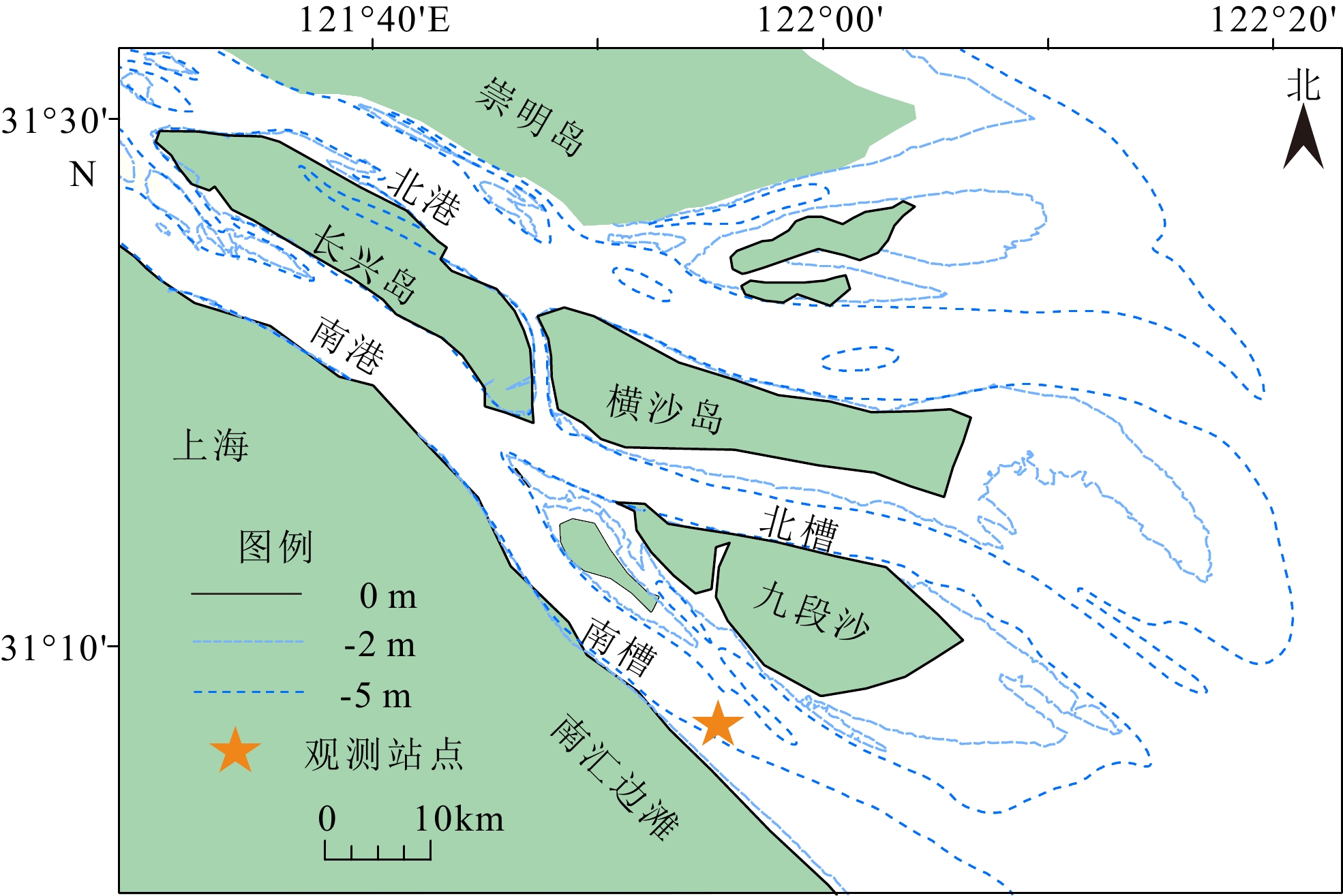
 下载:
下载:








